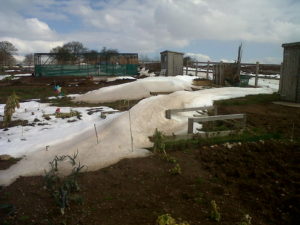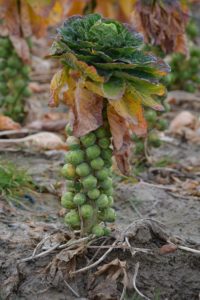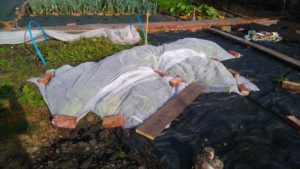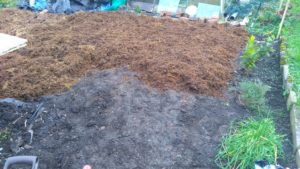December is a cold and wet month when many of us feel quite down that we can’t get outside and enjoy our allotment or garden. Despite the frost and snow there is still plenty that can be done both outside and in the warmth of your home.
The cold weather is surprisingly useful to you as a gardener. It kills off pests and diseases so that they do not build up. When winter isn’t cold enough there is always a big problem with diseases and pests the following year. The frost can also help break down soil that you have dug over and is necessary for some plants to germinate or fruit.
(This picture shows the snow drift I woke up to find on my allotment one year … underneath there was both onions and garlic which surprisingly enough survived and produced a great crop)
So, what can you do in the cold month of December?
Harvesting
There isn’t a lot to harvest in this month. You may have some potatoes planted for Christmas that you can lift and brassicas that can also be harvested. If the weather is particularly cold and wet, then root vegetables are best lifted to prevent rot.
Parsnips and leeks can be left on the ground, the former benefits from frost as it turns the starches into sugars giving a sweeter, tastier parsnip. However, if the ground freezes these can be difficult to dig up and if it gets too waterlogged then they can rot. If this is the case, lift them and store them in containers of soil or compost. Cabbages and Brussels sprouts can be stored in a similar way.
Keep an eye on your sprouts as they can blow open and be ruined. You may need to harvest these and store them if they look like they are going beyond ready.
You may also be harvesting the last of your crops from your greenhouse.
Sowing and Planting
There isn’t much to be done here. If the soil isn’t frozen or waterlogged then you can plant garlic, but for most people it is too late. You can sow winter hardy broad beans under cover.
Now is the time to divide rhubarb crowns and plant bare root fruit trees and bushes.
Onion seeds can be sown in trays or pots towards the end of the month. These will need heat to germinate so a heated propagator or on a sunny windowsill.
December Jobs
Although there isn’t a lot of planting to do, there is still plenty of work to get on with. Most of these jobs are involve physical activity so they will keep you warm whilst on your plot.
Tender plants, both outdoors and in the greenhouse, need protecting from the cold. Fleece and bubble wrap are useful to wrap around pots and plants to help keep them warm. Bubble wrap can often be found for free from shops where it is used in packaging and then thrown away. If you have any outdoor water pipes then they will need lagging, as will your greenhouse irrigation system.
(This is my butternut squash plant fleeced to protect it from the frost. It was the first time I’d managed to get one to produce fruit due to its long growing season and was keen for the fruits to ripen without getting damaged by the frost. I got a great crop from this plant and managed to harvest them all without frost damage thanks to the fleece)
For the greenhouse owners, there is a bit more work. Make any repairs to your greenhouse, checking rubber seals and glass clips, replacing where necessary. Clear out your greenhouse and sweep out all plant debris and loose soil; this prevents pest or disease build up. Clean the glass, both inside and out with plant friendly disinfectant. Algae builds up on the glass which reduce the amount of light your plants receive. If you are overwintering plants in your greenhouse then choose a sunny, warmer day as you will need to put all the plants outside whilst you work. You may want to fleece them whilst they are outside to protect them from the worst of the cold.
Now is a good time to clean, oil and repair your tools. Sharpen any that need it and remove any rust with wire wool.
Fences and other structures should be checked for damage and any repairs made good. You may want to paint your shed or fences on a sunny day to protect the wood.
Check through your pot and seed tray collection, throwing away any that are damaged. You can replace them now or ask Santa to bring you new ones!
December to mid-February is a good time to prune apples and pear trees. Gooseberries and currant hushes can also be pruned back at this time of year. Autumn fruiting raspberries can be cut back to ground level. Stone fruits such as plums and gauges should be left until summer before pruning to prevent silver leaf disease.
Cut away any dead, damaged or diseased branches as well as crossing or rubbing branches. For gooseberries you want an open goblet shape to allow for good air circulation. Train your apple and pear trees into the shape you desire.
If you grow grape vines, then these need pruning before Christmas otherwise they will bleed.
Earth up any Brussels sprouts and purple sprouting broccoli to give them extra stability in the winter winds. Any yellowing leaves should be removed and composted.
Now is a good time to manure your vegetable plot. You can use the manure as a top dressing or dig it in; its up to you. Put a manure mulch around your fruit trees and rhubarb, careful not to cover the crowns.
Your winter brassicas will need to be netted. Pigeons are hungry at this time of year and they will decimate your plants.
Providing the soil isn’t frozen or too waterlogged you can continue digging your plot to prepare it for spring planting.
Of course, when it is too cold or wet for you to work outside there is plenty to do indoors. You can sort through your seeds, throwing away those that are out of date. Plan your planting for the following year, including your crops rotation and any new seeds or tools you will need.
If you are not able to dig all of your beds, then cover them in black plastic or with tarps to keep the weeds down. Covering prepared beds will warm the soil so the beds are ready for planting slightly earlier.
This s also a good time for a general tidy up, not just around the plot but in your shed too. For most of us it will have degenerated into a state of chaos with constant use throughout the year. Have a good sort through and make good any repairs that are necessary.
If you have stored any fruit or vegetables for the winter, then check them to make sure they are OK. Any rotting or damaged items need removing as they could destroy your entire store.
Pests and Diseases
The only real problems you will encounter will be slugs and snails as they are problem throughout the year. Removing debris and tidying your plot will reduce their hiding places which will let the cold reduce this voracious pest’s numbers.
Mice and rats can be a problem. They will try to get at your stores as well as any broad beans or garlic you have planted. Take the usual precautions against them. Pigeons can also be a problem for brassicas crops which will need protecting with netting.
There is still plenty to do in December at your vegetable plot and the crisp, sunny winter days are a pleasure to be outside in. On wetter days there is lots to do in the shed or greenhouse plus fun to be had planning your next year!





























